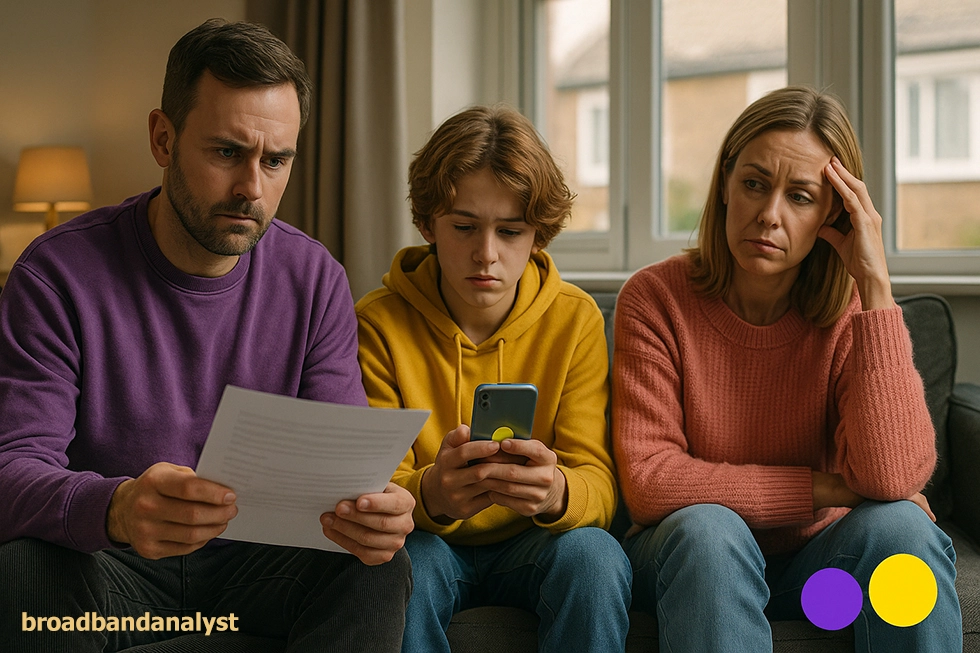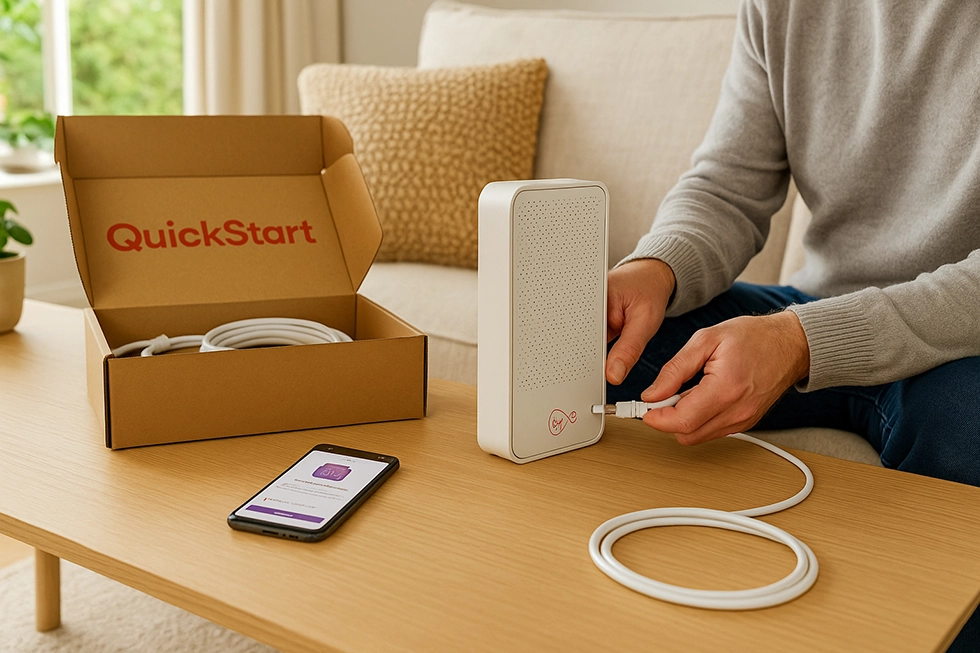BT has confirmed it will raise broadband prices by £4 annually for customers joining on or after 31 July 2025. This follows Ofcom’s regulatory update that replaced inflation-based mid-contract hikes with fixed, upfront increases. While the move brings greater pricing visibility, it also locks in steeper annual adjustments for consumers.

The change affects BT, Plusnet (from 5 August), and EE broadband customers. Existing customers on earlier broadband deals won’t see this new hike yet, but new sign-ups and recontracts will be subject to the fixed price rise from March 2026.
New Price Rules Explained: Fixed Costs vs Old Inflation Hikes
Ofcom banned the CPI + 3.9% pricing model in early 2025 to combat mid-contract confusion. Under the new rules, providers must now specify future price rises clearly, in pounds and pence, at the point of sale. BT initially implemented a £3 increase model. This is now rising to £4, a 33% jump, across all broadband and some mobile plans.
For broadband users, the £4 rise applies per month annually from 31 March 2026 onwards. EE’s Flex Pay mobile airtime plans, SIM-only contracts, and connected device bundles will also see fixed hikes between £1.50 and £4 depending on product type.
Will Other ISPs Follow BT’s Lead?
BT has historically set the pace for pricing changes in the UK telecoms market. When it alters billing structures, other major providers—like TalkTalk, Vodafone, and Sky—tend to align. While many ISPs adopted the £3 model post-Ofcom reform, BT’s move to £4 suggests others may now follow with similar or higher fixed increases.
These adjustments often take hold quietly across the industry within a few months. The fixed pricing model offers predictability for customers but allows providers to front-load future cost recovery, especially in a high-inflation environment.
Why Prices Are Still Going Up Despite More Regulation
Although Ofcom’s goal was greater billing transparency, the rules don’t restrict how much providers can charge—only that they explain it upfront. With inflation fluctuating and infrastructure investment costs climbing, many ISPs are embedding higher fixed increases to offset financial risk.
Fixed pricing may prevent surprise bills, but for consumers, it often translates to guaranteed price hikes that are baked into contracts from day one. In effect, transparency doesn’t equal affordability.
The Push for Full Fibre Is Raising Costs
BT and its infrastructure arm Openreach are investing heavily in fibre-to-the-premises (FTTP) deployment. Their goal is to reach 30 million premises by the end of the decade. Virgin Media O2, Nexfibre, and CityFibre are making similar long-term bets on full fibre coverage across the UK.
These fibre rollouts require sustained capital expenditure, and the cost recovery often trickles down to consumers. The shift from copper (FTTC) to fibre means more stable speeds and low latency, but also higher base pricing—especially in areas without sufficient retail competition.
Cheap Broadband Options Without Price Hikes
Smaller full fibre ISPs such as Community Fibre, Hyperoptic, YouFibre, and G.Network continue to offer contract terms without mid-contract increases. These operators build and operate their own FTTP networks or lease wholesale access on better terms, allowing them to offer more stable pricing.
Plans from these altnets often include symmetrical speeds—upload and download speeds matched—and simpler billing structures without bundled upsells or surprise charges. In cities where multiple FTTP networks compete, consumers can still find reliable gigabit broadband with static pricing for 12 or 24 months.
Do Loyal Customers Still Pay More in 2025?
Ofcom’s pressure on loyalty penalties has had some impact, but many customers still pay significantly more after the initial term. Long-term users often don’t realise they’ve slipped onto a variable tariff until prices spike.
While providers must notify users about price changes, retention offers aren’t always transparent. Recontracting is often incentivised with reward cards or bill credit, but real savings depend on whether the user is locked into an escalating pricing structure.
Package Deals May Look Cheap – But Are They?
The rise of packaged deals—broadband bundled with mobile, TV, and streaming—has introduced additional layers of complexity. While these bundles may offer perceived value, they often include teaser pricing, escalating mid-contract costs, and limited flexibility for switching.
Common issues include non-transparent router rental fees, usage caps on mobile SIMs within bundles, and post-contract price hikes that can increase monthly bills by £10 or more. Fixed price increases like BT’s new £4 hike apply across these bundles, adding to the total cost of ownership over time.
Why Cheaper Social Tariffs Are Still Hard to Get
While social tariffs exist for low-income users, eligibility criteria and limited marketing have hindered their uptake. Ofcom data from mid-2025 shows that less than 20% of eligible households are enrolled in discounted broadband plans.
With £4 annual increases and bundled charges creeping up, lower-income households are disproportionately affected. Providers have little incentive to promote social tariffs, and some make them difficult to access without active customer request.
Best Fixed-Price Broadband Deals to Watch
As of late July 2025, the best broadband packages with no CPI-linked price increases include:
- Community Fibre 1Gbps for £25/month, 24-month term, no price hikes
- YouFibre 800Mbps for £24/month, static contract, reward card included
- Hyperoptic 500Mbps for £26/month, 12-month fixed-price contract
- Fibrus Full Fibre 150 for £20/month in Northern Ireland and parts of Scotland
These deals avoid automatic price rises and offer symmetrical speeds with low latency, suitable for home workers, streamers, and households with high upload demands.
Best Broadband Deals – Fixed Price, Faster Speeds, Excellent Support
Choose from our handpicked broadband packages offering fixed monthly pricing, full fibre speeds, and trusted customer support. No surprises, just solid value.
Compare Special OffersHow to Stay Ahead of Contract Hikes
Consumers can still stay in control with a few practical steps:
- Use postcode-based comparison tools to check FTTP availability from multiple providers
- Avoid bundling broadband with mobile/TV unless the cost breakdown is transparent
- Choose 12–24 month plans with fixed monthly pricing and clear contract end dates
- Avoid re-contracting without reviewing current offers—sometimes switching saves more
- Track deal expiration dates to avoid falling into higher out-of-contract tariffs
Transparent Pricing Is Just the Beginning
BT’s move to £4 mid-contract rises marks a new phase in UK broadband pricing: more visible, but not necessarily fairer. With ISPs aiming to balance infrastructure costs and revenue, fixed hikes are replacing variable ones—but the cost still climbs either way.
For broadband users, the real challenge is navigating a market where clarity has improved but affordability has not. Smaller ISPs with simpler terms remain the best option for value-seeking customers, especially in fibre-enabled areas.
The UK broadband market is evolving fast. Regulation is catching up. But for now, staying informed, switching regularly, and reading the fine print are still the best tools customers have to keep bills in check.










